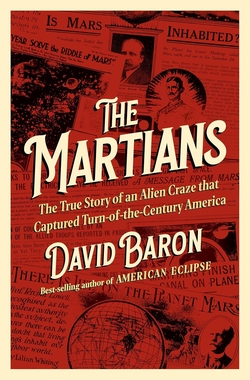Centauri Dreams
Imagining and Planning Interstellar Exploration
Exoplanet Moons in Formation?
We’ve been looking at circumstellar disks for quite some time, and teasing out images of actual planets within them, as witness HR 8799, where four exoplanets have been found. Just recently we saw imagery of a second world around PDS 70, both planets seen by direct imaging as they plowed through the disk of dust and gas surrounding a young star. All told, we now have more than a dozen exoplanets that have been directly imaged, though only two are in multi-planet systems. PDS 70b is sweeping out an observable gap in the disk.
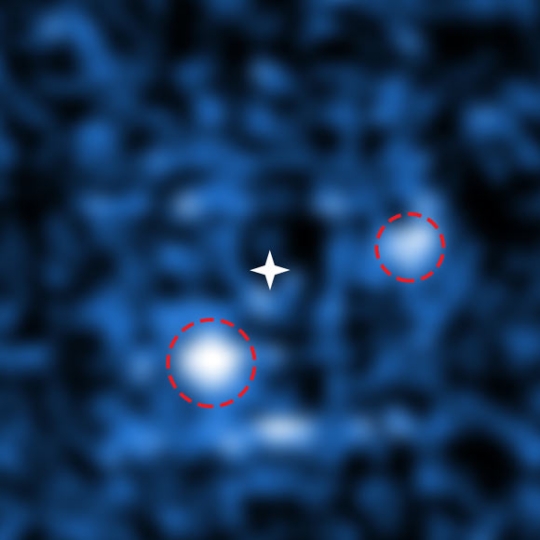
Image: PDS 70 is only the second multi-planet system to be directly imaged. Through a combination of adaptive optics and data processing, astronomers were able to cancel out the light from the central star (marked by a white star) to reveal two orbiting exoplanets. PDS 70 b (lower left) weighs 4 to 17 times as much as Jupiter while PDS 70 c (upper right) weighs 1 to 10 times as much as Jupiter. Credit: ESO and S. Haffert (Leiden Observatory).
Now we learn that within the same system, we have evidence for the first circumplanetary disk, forming around PDS 70b, the innermost of the two worlds. The planet is about 3.2 billion kilometers from the host star, in an orbit roughly similar to that of Uranus in our own system, and was discovered last year before recent work revealed the existence of PDS 70c. The study, led by Monash University (Australia) and including an international team, worked with an algorithm developed to extract faint signals from Very Large Telescope data.
Led by Valentin Christiaens at Monash, the team worked at infrared wavelengths to analyze the spectrum of the planet produced by SINFONI (Spectrograph for INtegral Field Observations in the Near Infrared) at the VLT, analyzing three hypotheses to explain what they saw. The best fit to the data was a model that incorporated a developing atmosphere as well as a circumplanetary disk, for atmospheric models alone could not account for the observed flux.
Here’s the image that appears in the paper on this work:
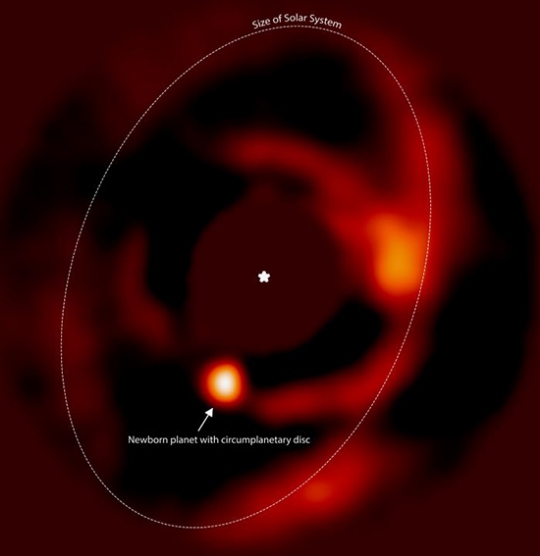
Image: Infrared image of the newborn planet PDS 70 b and its hypothesized circumplanetary disc, within its birth environment. Size of the Solar System given for comparison. Credit: V. Christiaens et al./ ESO.
This is a tentative finding, as the authors acknowledge. They list several caveats, including their use of a limited range of atmospheric models and a data fit that is not perfect. The paper also discusses the possibility that the assumptions between their circumplanetary disk models may be incorrect. But supporting the circumplanetary disk result is the fact that the team’s calculated accretion rates for the planet agree with observation, while the presence of specific carbon monoxide emission features supports a forming accretion disk around the planet.
And there is this:
Presence of a spiral arm. Our conclusion regarding the presence of circumplanetary material around PDS 70 b is consistent with recent images obtained with VLT/SINFONI, suggesting the presence of an outer spiral arm likely feeding the CPD [circumplanetary disk].
If follow-up observations can firm up the hypothesis, we would be seeing a newborn giant planet forming its own family of satellites, much as many scientists believe Jupiter did as it evolved in the circumstellar disk. There is also the interesting 2:1 resonance in the two planetary orbits, so that the inner planet orbits twice for every single revolution of the outer world. What bearing this may have on theories of giant planet migration in our own system may become clearer as we examine more young exoplanets that display the same kind of resonance.
If we do have a satellite-forming disk around a planet here, we can add that to the mix as we try to firm up our models of giant planet formation. “Despite an intensive search circumplanetary discs have until now eluded detection,” says Christiaens. “This first piece of evidence suggests theoretical models of giant planet formation are not far off.”
The paper is Christiaens et al., “Evidence for a Circumplanetary Disk around Protoplanet PDS 70 b,” Astrophysical Journal Letters Vol. 877, No. 2 (3 June 2019). Abstract / Preprint. The discovery of the second young planet around PDS 70 is discussed in Haffert et al., “Two accreting protoplanets around the young star PDS 70,” Nature Astronomy 3 June 2019 (abstract).

1999 KW4: Close-Up of a Double Asteroid
I’ve argued in these pages that the interstellar effort will be driven as much by planetary protection as by the human exploratory impulse. I count the latter as crucial, but we often think of planetary protection as an immediate response to a specific problem. Let’s place it, though, in context. Now that we’re actively cataloging asteroids that come near the Earth, we have to know how and when to react if what looks like a dangerous trajectory turns into a deadly one. That mandates a continued level of observation and progress on mitigation technologies.
A small nudge counts for a lot with an object that’s a long way out, and we can’t exclude, for example, long period comets in our thinking about planetary protection. So mitigation strategies that begin with changing the trajectory of a small, nearby object will grow with our capabilities to encompass more distant options, and that incentivizes the building of a defensive infrastructure that can operate deep into the Solar System. We need deep space technologies that can not only form a warning network but a defensive screen in case a threat develops.
We’ll build out a Solar System infrastructure one day that can do these things, one with inevitable consequences for the technologies that also foster exploration far beyond Sol. So when I see the recent images of the asteroid 1999 KW4, I’m also reminded of another binary asteroid called Didymos. With its companion (‘Didymoon’), Didymos is to be the subject of a NASA asteroid mitigation experiment, in which the DART spacecraft will impact the small moon in 2022 to gauge orbital changes that can be induced around the larger object. The European Space Agency will follow up with data from the asteroid in 2026 in a mission called Hera.
As to DART itself, the acronym stands for Double Asteroid Redirection Test. We’re talking about an impactor demonstrating the kinetic effects on the tiny object to see just how effective a deflection strategy may be. Didymos is not an Earth-crosser but it does provide a useful venue for the experiment. It’s worth remembering that a variety of options exist for asteroid mitigation, but DART will offer the first kinetic impact test at a scale realistic for planetary defense.

Image: Schematic of the DART mission shows the impact on the moonlet of asteroid (65803) Didymos. Post-impact observations from Earth-based optical telescopes and planetary radar would, in turn, measure the change in the moonlet’s orbit about the parent body. Credit: NASA/Johns Hopkins Applied Physics Lab.
But back to 1999 KW4. which was imaged by the SPHERE instrument (Spectro-Polarimetric High-Contrast Exoplanet Research) on the European Southern Observatory’s Very Large Telescope. SPHERE was designed to be an exoplanet hunter using adaptive optics to screen out atmospheric distortion, but it proved its mettle much closer to home by providing sharp images of an asteroid just 1.3 kilometers wide that flew by the Earth in late May, offering the opportunity for an observing campaign coordinated by the International Asteroid Warning Network (IAWN).
“These data, combined with all those that are obtained on other telescopes through the IAWN campaign, will be essential for evaluating effective deflection strategies in the event that an asteroid was found to be on a collision course with Earth,” said ESO astronomer Olivier Hainaut. “In the worst possible case, this knowledge is also essential to predict how an asteroid could interact with the atmosphere and Earth’s surface, allowing us to mitigate damage in the event of a collision.”
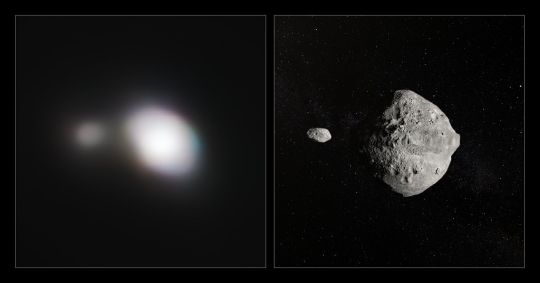
Image: The unique capabilities of the SPHERE instrument on ESO’s Very Large Telescope have enabled it to obtain the sharpest images of a double asteroid as it flew by Earth on 25 May. While this double asteroid was not itself a threatening object, scientists used the opportunity to rehearse the response to a hazardous Near-Earth Object (NEO), proving that ESO’s front-line technology could be critical in planetary defence. The left-hand image shows SPHERE observations of Asteroid 1999 KW4. The angular resolution in this image is equivalent to picking out a single building in New York — from Paris. An artist’s impression of the asteroid pair is shown on the right. Credit: ESO.
The two components of 1999 KW4, separated by about 2.6 kilometers, were moving at approximately 19.5 kilometers per second as they flew past the Earth, a challenge for observers not only because of their faintness and fast motion, but because atmospheric conditions were unstable at the time and the SPHERE adaptive optics system crashed more than once, though operations were quickly restored. The asteroid and tiny satellite reached a minimum distance of 5.2 million kilometers from Earth on May 25, about 14 times the distance to the Moon.

An Atomic Clock for Deep Space
NASA’s Orbital Test Bed satellite is scheduled for launch via a SpaceX Falcon Heavy on June 22, with live streaming here. Although two dozen satellites from various institutions will be aboard the launch vehicle, the NASA OTB satellite itself houses multiple payloads on a single platform, including a modular solar array and a programmable satellite receiver. The component that’s caught my eye, though, is the Deep Space Atomic Clock, a technology demonstrator that points to better navigation in deep space without reliance on Earth-based atomic clocks.
Consider current methods of navigation. An accurate reading on a spacecraft’s position depends on a measurement of the time it takes for a transmission to flow between a ground station and the vehicle. Collect enough time measurements, converting them to distance, and the spacecraft’s trajectory is established. We know how to do atomic clocks well — consider the US Naval Observatory’s use of clocks reliant on the oscillation of atoms in its cesium and hydrogen maser clocks. Atomic clocks at Deep Space Network ground stations make possible navigational readings on spacecraft at the expense of bulk and communications lag.
While GPS and other Global Navigation Satellite Systems (GNSS) use onboard atomic clocks, the technologies currently in play are too heavy for operations on spacecraft designed for exploration far from Earth. That puts the burden on communications, as distant spacecraft process a signal from an atomic clock on the ground. What the spacecraft lacks is autonomy.
A better methodology is something we have to develop as we look toward a future deep space infrastructure. Testing the miniaturization of atomic clocks and methods to harden them for operations elsewhere in the Solar System is the goal of the DSAC demonstrator mission, which points to a clock architecture that is considerably more efficient and also scalable.
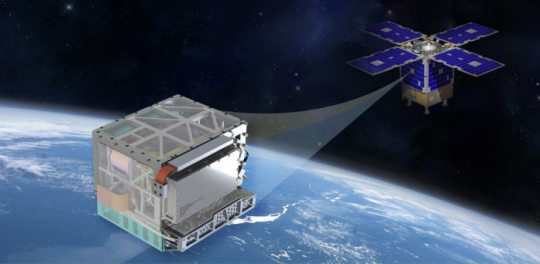
Image: JPL’s Deep Space Atomic Clock will fly aboard the General Atomics Electromagnetic Systems Orbital Test Bed satellite as a hosted payload and launched in June as part of the U.S. Air Force’s Space Technology Program 2. Credit: NASA.
The Deep Space Atomic Clock will be the first atomic clock designed to fly aboard a spacecraft going beyond Earth orbit and, with a stability of better than one microsecond in a decade, it is also the most precise clock ever flown. Ground-based testing has shown that the DSAC is up to 50 times more stable than the atomic clocks on GPS satellites, losing only one second in nine million years. NASA considers it an enabling device for future on-board radio navigation.
It is the length of a second as measured by the frequency of light released by specific atoms that makes an atomic clock so precise as it records the vibrations induced in a quartz crystal. Key to the DSAC clock’s stability is the use of mercury ion trap technology. Contained within electromagnetic traps within the device, these ions are rendered less vulnerable to external forces like changing magnetic fields and variations in temperature than atoms currently in use.

Image: DSAC mercury ion trap housing with electric field trapping rods seen in the cutouts. This is where DSAC interrogates and measures the mercury ion resonance that is used to discipline a quartz crystal clock. Credit: NASA.
The distances involved in deep space operations force new technologies upon us, for communicating with atomic clocks on Earth to determine a spacecraft’s location not only takes time but also places an increased burden on our communication resources, another reason why we’re moving toward networking multiple spacecraft in orbital operations at places like Mars.
The plan is to test DSAC in Earth orbit for one year, with the goal of adapting it for future missions to deep space. Developed at the Jet Propulsion Laboratory, the device has been under development for 20 years, reducing the size of atomic clocks from those used at Deep Space Network ground stations — about the size of a refrigerator — to an object the size of a four-slice toaster, and one that can be further miniaturized depending on the needs of future missions.
You can see that we’re gradually upping the navigation service volume, considering that spacecraft near Earth don’t require an integrated atomic clock, being able to use existing global navigation services like GPS. These technologies, using multiple GNSS constellations, can get us out as far as geosynchronous orbit, and DSAC promises accurate navigation deep into the Solar System. Ahead lies X-ray navigation that keys off the oscillations of remote pulsars, a galactic positioning system that points to missions moving, one day, far beyond our Sun.

A Supernova Link to Ancient Wildfires?
Did huge fires several million years ago force a transition from forest to savanna in northeast Africa? It’s a tantalizing thought, as such fires have been seen as a possible factor in driving the emergence of bipedalism in our remote ancestors. Adrian Melott (University of Kansas), who looks at the question in a new paper in the Journal of Geology, notes that our precursors would have adapted to such massive changes to their habitat, evolving to support life amidst the abundant grasslands that had replaced their former tree-filled environments.
The conjecture about early hominins is receiving a lot of attention, but it plays only a small role in this paper, which focuses on the linkage between supernovae activity and the period in question. Just how do we make the call on a nearby supernova? Melott has been studying the question for some time, and refers back to 2016 studies of ancient seabed deposits of iron-60 isotopes that appeared in Nature. At that time, two supernovae events, one from 1.7 to 3.2 million years ago, the other from 6.5 to 8.7 million years ago, were identified via iron-60 deposits.
The new study points to the accumulating evidence for supernovae in the vicinity of the Earth, finding the strongest signal at 2.6 million years, and notes that this may represent a series of supernovae beginning as far back as 7 million years that Melott relates to the clearing out of the Local Bubble, which is a cavity in the interstellar medium in the Orion Arm in which our own Local Interstellar Cloud is located. Supernovae are thought to have emptied this cavity.
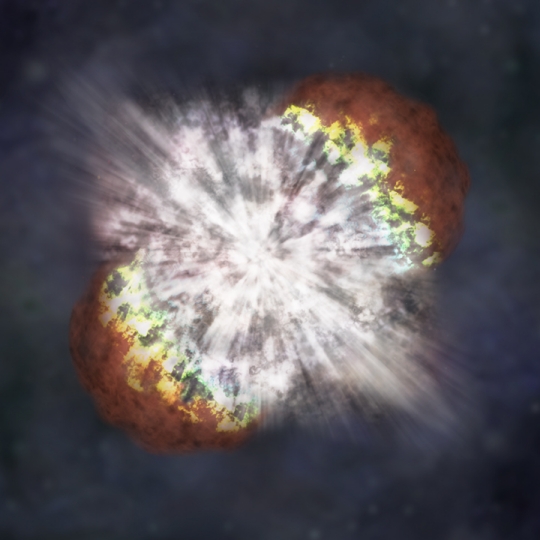
Image: Supernovae bombarded Earth with cosmic energy starting as many as 8 million years ago, with a peak some 2.6 million years ago, initiating an avalanche of electrons in the lower atmosphere and setting off a chain of events that conceivably ended with bipedal hominins such as homo habilis. Credit: NASA.
In the paper, Melott and colleague Brian Thomas (Washburn University) assume a supernova occurring 2.6 million years ago at a distance of 50 parsecs, or 163 light years, a time after the Local Bubble had already formed. The authors compute the extent of cosmic ray propagation and consider effects on terrestrial life, with particular regard to muons, the highly penetrating elementary particles that are the primary component of cosmic ray irradiation at the surface.
A key result is increased ionization of the atmosphere as a result of supernovae cosmic rays, with ‘electron avalanches’ set off that are the primary initiator of lightning (a still controversial idea, though one the authors cite recent evidence to support). From the paper:
A 50 times increase in atmospheric ionization in the troposphere would clearly make the breakdown and electron cascade much easier, and one could expect a great increase in lightning (e.g. Erlykin and Wolfendale, 2010). Furthermore, the originally isotropic distribution of cosmic rays would result in showers which are much more preferentially vertical, due to the variation in atmospheric column density with angle. So, not only would lightning be enhanced, but cloud-to-ground lightning should be preferentially enhanced. The theory of lightning initiation is not well-developed, and we cannot say that a 50-fold increase in ionization would lead to a 50-fold increase in the number of lightning events. However, the potential is there for a large increase.
As the paper notes, lightning is the main initiator of wildfires (excluding humans), and an increase in lightning strikes would be expected to induce large numbers of wildfires. The conversion of forest to savanna, a worldwide phenomenon beginning about 7 million years ago, may have been caused by the increase in wildfires associated with this period, as found in soot and other carbon-related sediments. Thus the notion, not emphasized in the paper, that supernovae could have played a role in human evolution. Here’s Melott on the matter:
“The observation is that there’s a lot more charcoal and soot in the world starting a few million years ago. It’s all over the place, and nobody has any explanation for why it would have happened all over the world in different climate zones. This could be an explanation. That increase in fires is thought to have stimulated the transition from woodland to savanna in a lot of places — where you had forests, now you had mostly open grassland with shrubby things here and there. That’s thought to be related to human evolution in northeast Africa. Specifically, in the Great Rift Valley where you get all these hominin fossils.”
Supernovae are not frozen in time, so the logical question is whether events like these could occur in our future. A possible future Type II supernova (resulting from the collapse of a massive star and subsequent explosion) can be found in Betelgeuse, which may light up the skies sometime in the next million years, according to current estimates. But at 200 parsecs, it is not likely to cause major consequences. Melott and Thomas see solar events as far more concerning as we consider solar flares in the context of our technological civilization.
The paper is Melott and Thomas, “From cosmic explosions to terrestrial fires?” published online by the Journal of Geology 28 May 2019. Abstract / Preprint.

Explaining Luna’s Farside
The Moon’s farside used to be a convenient setting for wondrous things. After all, no one had ever seen it, setting the imagination free to insert everything from paradisaical getaways (think Shangri-La in space) to secret technologies or alien civilizations. The Soviet Luna 3 image of 1959 took the bloom off that particular rose, but we also learned through this and subsequent missions that farside really does have its differences from the familiar face we see. More craters, for one thing, and fewer of the dark plains we call maria, or ‘seas.’
We can throw in measurements made by the GRAIL mission (the Gravity Recovery and Interior Laboratory) in 2012. GRAIL was a NASA Discovery-class mission that performed gravitational field mapping of the Moon as a way of examining its internal structure, a set of two probes that worked by analyzing measured changes in distance between the two craft as small as one micron. We wound up with a map of our satellite’s gravitational field that led to deeper understanding of its crust, its thermal evolution and its subsurface structure.
Here again we find variation between farside and what we see from Earth. The Moon’s crust is thicker and contains an additional layer on farside. In fact, the farside crust is on the order of 20 kilometers thicker than nearside, and GRAIL’s remote sensing data tell us that this extra crustal material is composed of silicate minerals, magmas, and rocks which are relatively high in the heavier elements. A collision between a dwarf planet and the Moon that occurred after the Moon had already formed a solid crust is now emerging as one explanation for these differences.

Image: Artist’s depiction of a collision between two planetary bodies. New research suggests the stark difference between the Moon’s heavily-cratered farside and the lower-lying open basins of the nearside were caused by a wayward dwarf planet colliding with the Moon in the early history of the solar system. Credit: NASA/JPL-Caltech.
The research presenting the theory is being led by Meng Hua Zhu of the Space Science Institute at Macau University of Science and Technology. Zhu and colleagues are using GRAIL data as fodder for computer simulations that work through impact scenarios for the early Moon, some 360 of them, to see whether they can reproduce the crustal variation we see today.
The work has produced a model that fits the bill, involving the impact of an object a bit smaller than Ceres (780 kilometers in diameter) striking the Moon’s nearside at 22,500 kilometers per hour. A second fit to the data is a smaller (720 kilometer) object hitting at 24,500 kilometers per hour. In both cases, material blown off the surface would fall back to bury the farside crust in kilometers of debris, which fits the additional crust layer found by the GRAIL mission.
Wouldn’t we see evidence on the nearside of such a titanic collision? Depending on conditions in the early Moon, the telltale signs may be hard to tease out, but the authors believe their model can explain the farside highlands and the nearside lowlands, noting such nearside features as “a large area of low-Ca pyroxene on the nearside observed by Kaguya mission that was explained to be formed via impact through melting a mixture of crust and mantle materials.” Let me quote more from the paper on this, talking about the formation of a ‘mega basin’ covering most of nearside:
…the mega basin structure may not be the same to the surface expression of a typical basin formed later. It is likely that the morphologies of mega basin were heavily modified and possibly even erased due to high internal temperature of the early Moon (Miljkovic et al., 2017), which easily allowed for isostatic relaxation processes (Freed et al., 2014). Therefore, it is highly possible that remnants of a giant impact on the early Moon may be less pronounced and significantly different from the impact basins formed later. To test whether a giant impact on the nearside is a plausible mechanism for the formation of Moon’s asymmetries, we performed a systematic numerical modeling study and quantified the outcome of such impact events.

Image: The basin-forming process for an impactor 780 kilometers in diameter (with a 200-kilometer diameter of iron core) with an impact velocity of 22,500 kph (14,000 miles per hour). In each panel, the left halves represent the materials used in the model: gabbroic anorthosite (pale green), dunite (blue), and iron (orange) represent the lunar crust, mantle, and core, respectively. The gabbroic anorthosite (pale yellow) also represents the impactor material. The right halves represent the temperature variation during the impact process. The arrows in (C) and (D) represent the local materials that were moved and formed the new crust together with deposits of material that was blasted from the impact. Credit: JGR: Planets/Zhu et al. 2019/AGU.
Simulating the impact scenarios produces variation in post-impact ejecta and crustal thickness that can reproduce the Moon’s current crust in the farside highlands. The giant impact also fits data on isotope variation in potassium, phosphorus and tungsten-182 between the surfaces of the Moon and the Earth, with the authors positing that these elements would have been added to the Moon’s constituents after its formation. The paper suggests that the impact of an 800-900 kilometer-sized body with the Moon is not unlikely given that the Moon received roughly half of the number of impacts as Mars, many in the form of planetesimals from the early system.

Image: The topographic (A), crustal thickness (B), and thorium distribution of the Moon show a dramatic difference between the nearside and farside. The star on the nearside represents the center of the proposed impact basin. The black dashed lines represent the boundary of Imbrium (Im), Orientale (Or), and Apollo (Ap) basin, respectively. Credit: JGR: Planets/Zhu et al. 2019/AGU.
My own interest in this paper is not so much the Moon itself as the fact that our abundant data on our satellite may help us understand the kind of asymmetries between hemispheres that can occur on large objects as the period of planet formation is drawing to its close. All that is part of learning about the origins of our own Solar System as well as conditions in the young systems we are now beginning to measure in circumstellar disks like the one at HD 163296 that I looked at on Friday (see HD 163296: Emerging Insights into Circumstellar Disks).
The paper is Zhu et al., “Are the Moon’s nearside?farside asymmetries the result of a giant impact?” Journal of Geophysicl Research: Planets 20 May 2019 (abstract).

HD 163296: Emerging Insights into Circumstellar Disks
We should be glad to run into the unexpected when doing research, because things we hadn’t foreseen often point to new understanding. That’s certainly the case with infant planetary systems as observed through the circumstellar disks of gas and dust surrounding young stars. ALMA (the Atacama Large Millimeter/submillimeter Array) has been central to the study of such targets. An array of 66 radio telescopes in Chile’s Atacama Desert, the facility works at millimeter and submillimeter wavelengths to provide detailed imaging of emerging systems.
Because it has been revealing a variety of small-scale structures within circumstellar disks, ALMA is giving us insights into planet formation as we observe gaps, rings and spiral arms and their interactions with young planets. This is where the unexpected comes in. For researchers looking at a 5 million year old star called HD 163296 are seeing an unusual amount of dust, more than 300 times the mass of the Earth, despite the detection of at least three proposed planets whose masses range between that of Jupiter and twice that of Uranus.
HD 163296 is a Herbig Ae/Be star, a pre-main-sequence object still embedded in a gas-dust envelope. The star has about twice the mass of the Sun, with a massive disk accounting for approximately one tenth of the Sun’s mass. The disk is about 500 AU wide, making it perhaps twice the outer boundary of our own Kuiper Belt. It’s noteworthy that the disk remains as abundant as it is given the age of the system and its production of at least three planets.
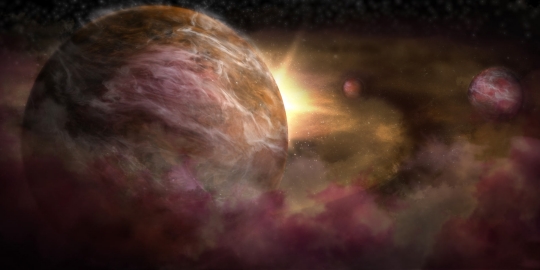
Image: Artist’s impression of protoplanets forming around a young star. Credit: NRAO / AUI / NSF / S. Dagnello.
The conventional model of dust distribution in this environment is migration from the outer regions of the disk inward because of coupling and friction with abundant gas, and the assumption has been that this migration would be stopped by the presence of massive planets. The hypothesized result: Dust piling up outside the orbits of the massive planets, while clearing out inside the orbit of the innermost planet as the dust migrates onto the star.
But the new ALMA observations, in tandem with the researchers’ dynamical simulations of this system and their application of a collisional model to test various outcomes, show a different result. The orbital regions inside the first planet, as well as between the first and second planet, have some of the highest concentrations of dust anywhere in the disk. The new work looks at this dust distribution in terms not only of interactions with gas and the new planets but also with what must be a large population of planetesimals, small objects that provide the building blocks of planet formation.
Diego Turrini is lead author of the study and a researcher at the Institute for Space Astrophysics and Planetary Science (IAPS) of the Italian National Institute of Astrophysics (INAF):
“From the study of the Solar System we know that mature circumstellar disks like HD 163296 are not composed only by gas and dust, but also contain an invisible population of small planetary objects similar to our asteroids and comets. We also know that the appearance of giant planets affects these planetesimals by causing in their orbital evolution a brief but intense spike of dynamical excitation that, while short from the point of view of the long life of a planetary system, can have a duration comparable to the life of circumstellar disks.”

Image: The circumstellar disk surrounding HD 163296 and the system of gaps and rings created by its young giant planets as recently imaged by ALMA (DSHARP Project). Credit: ALMA (ESO/NAOJ/NRAO), S. Dagnello.
Thus the dynamical simulations calculated to show these interactions and test their limits. What emerges is a regime of planetesimal collisions that remains relatively calm until the giant planets reach their ultimate masses. As the planets grow, more and more planetesimals are driven into eccentric, inclined orbits. At this point, planetesimal collisions become intense. We now have an explanation for the renewed dust in the system, and an orbital distribution of that dust markedly different from before, one where dust accumulates in the inner orbital region of the first planet and also forms a ring between the first and second planets.
These findings jibe with the ALMA observations, linking simulations to a living system. Thus Danai Polychroni, co-author of the study and at the time professor at the Universidad de Atacama and adjunct researcher at INAF-IAPS:
“The fast rate at which ALMA is providing new and more detailed data on HD 163296 allowed us to expand our study beyond its original scope. We noticed that many planetesimals are excited to supersonic velocities with respect to the surrounding gas of the disk and can create shocks waves that can heat both planetesimals and gas. While we could not yet model this process in detail, recent observations reported the unexpected presence of CO gas in regions characterized by temperatures where it should be frozen solid and of possible anomalies in the thermal structure of the disk. Both findings can in principle be explained thanks to the presence of these supersonic planetesimals and the shock waves they create.”
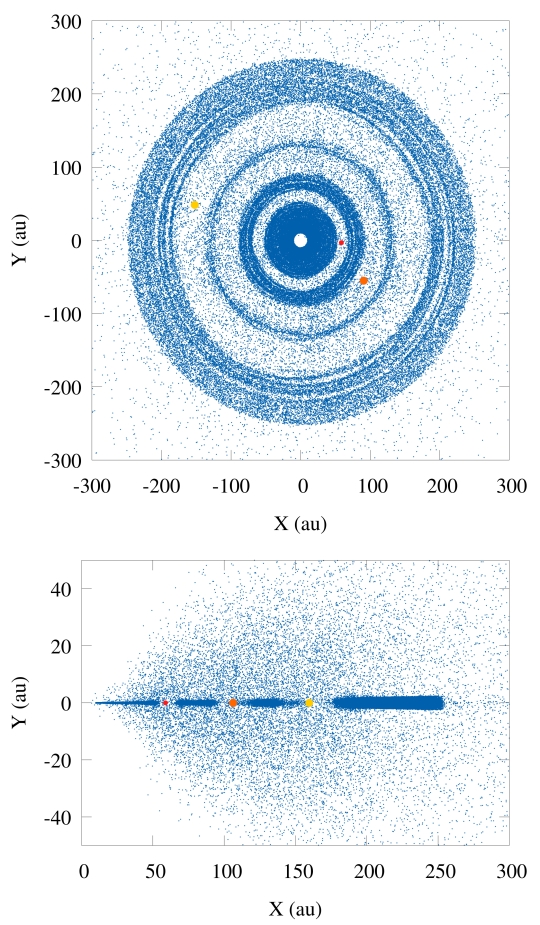
Image: The disk of icy planetesimals hidden in HD 163296’s circumstellar disk seen from above and the side. The young giant planets rapidly create a large population of exocomets acting as high-speed projectiles for the other bodies. Credit: D. Turrini (INAF-IAPS).
We’ve learned, then, that the formation of planets in a circumstellar disk can produce dynamical excitation leading to a resurgence in the ratio of dust to gas that halts the decay of the dust by creating second-generation dust grains through high-velocity collisions. This is useful stuff, for we’re observing more and more possible planets emerging in disks in which planetesimals should be widespread. The disk around HD 163296 may be showing us a stage of planet and system evolution that is common, and one we can now look for in a range of young systems.
From the paper:
The collisional production of second-generation dust in circumstellar disks hosting giant planets …likely represents a common evolutionary phase marking the transition from a circumstellar disk dominated by primordial dust to a debris disk dominated by second generation dust. Whether the amount of collisionally produced dust is high enough to produce observable signatures, like our results suggest being the case for HD 163296’s disk…depends on the characteristics of each specific system, first of all the masses of the giant planets and of the planetesimal disk.
The paper is Turrini et al., “Dust-to-gas ratio resurgence in circumstellar disks due to the formation of giant planets: the case of HD 163296,” Astrophysical Journal Vol. 877, No. 1 (23 May 2019). Abstract / Preprint.

